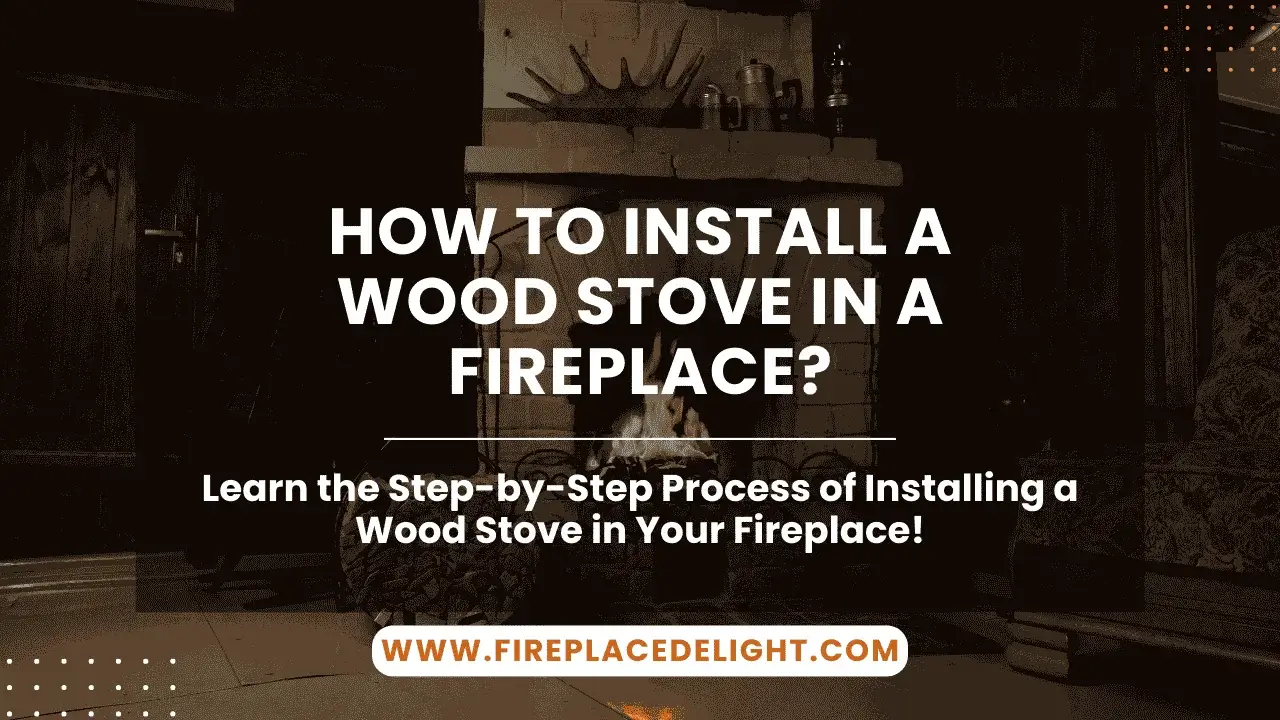Installing a wood-burning stove in an existing fireplace is a great way to improve your home’s heating efficiency, add warmth, and create a cozy ambiance during the colder months. However, transforming your traditional fireplace into a wood stove setup requires careful planning and consideration.
From evaluating the condition of your chimney and flue to ensuring the stove is installed at a safe distance from combustible materials, there are several factors to keep in mind. Whether you’re upgrading an old fireplace or simply enhancing your current heating system, it’s important to understand the key steps involved and the costs associated with the installation.
In this guide, we’ll walk you through the essential things to consider, the process of installing a wood-burning stove, and what you can expect in terms of cost.
How to Install a Wood-Burning Stove into an Existing Fireplace?
Installing a wood-burning stove into an existing fireplace can be an excellent way to increase heating efficiency, reduce heating costs, and add ambiance to your living space. However, it is crucial to ensure that the installation is done safely and correctly. Since you’re working with an already established fireplace, there are a few considerations and steps to take to ensure that the installation meets safety standards and maximizes the stove’s performance. Here’s a guide to help you through the installation process, starting with important factors to consider before getting started.
Things to Consider When Installing a Wood-Burning Stove in an Existing Fireplace
Consider the Chimney and Flue Size of Your Existing Fireplace
One of the most important factors to consider when installing a wood-burning stove is the size of the chimney and flue. Your existing fireplace may have a chimney that is designed for an open fire, which can differ from the specific requirements needed for a wood stove. The flue must be the correct size to allow for proper airflow and exhaust of smoke and gases. If the existing chimney or flue is too small, you may need to install a liner or replace it with a larger one to accommodate the stove and ensure proper venting. Proper ventilation is crucial for preventing dangerous buildup of smoke or carbon monoxide inside your home.
Read More: How To Check Your Fireplace For Carbon Monoxide?
How Far Will the Stove Be From Combustible Materials?
Safety is paramount when installing a wood-burning stove. It’s essential to ensure that the stove is placed at a safe distance from combustible materials such as wooden floors, walls, curtains, or furniture. Many wood stoves come with manufacturer guidelines outlining the minimum clearance requirements from these materials. Typically, wood stoves should be placed several feet away from walls, furniture, and other surfaces to prevent the risk of fire. If you’re unsure about the safety distances, it’s always best to consult a professional installer to ensure your stove is placed correctly.
Consider the Wood Burning Stove Heat Output
Wood-burning stoves are available in a variety of sizes, each offering different heat outputs. When installing a stove in your existing fireplace, you need to choose one that is appropriately sized for your room and heating needs. A stove that is too small won’t effectively heat your space, while one that is too large can lead to excessive heat buildup and potentially damage surrounding materials. Check the stove’s BTU (British Thermal Unit) rating to ensure it aligns with the size of the room you wish to heat. Additionally, be mindful of any potential airflow or ventilation restrictions in your existing fireplace that could impact the stove’s heat distribution.
Learn More: What Are The Side Vents On A Fireplace For?
Ensure You Have a Suitable Hearth in Place
The hearth serves as the base of your wood-burning stove and helps to protect the floor from any potential heat or sparks. Before installing your stove, ensure that the existing fireplace has a suitable hearth that can safely support the stove’s weight and heat output. The hearth should be made of non-combustible materials, such as stone or brick, to prevent the risk of fire. It should also extend far enough in front of and to the sides of the stove to catch any sparks or embers that may escape during use. If your existing hearth does not meet these requirements, you may need to modify it before proceeding with the installation.
By carefully considering these important factors, you can ensure a safe and effective installation of a wood-burning stove into your existing fireplace. Proper planning and preparation are key to maximizing both the performance and safety of your new heating source.
Installing a Wood-Burning Stove in an Old Fireplace
Installing a wood-burning stove in an old fireplace requires careful planning and consideration, as older fireplaces may not be equipped to handle the specific requirements of a modern stove. Some older fireplaces may have issues like outdated chimneys, insufficient ventilation, or lack of proper clearance from combustible materials. Here’s how to address these challenges:
Chimney and Flue Modifications:
Older chimneys may have a narrow flue, which could restrict airflow and cause inefficient combustion. You may need to install a new chimney liner that fits the wood stove’s venting requirements. This ensures that smoke and gases are properly vented out of the home, preventing the risk of carbon monoxide buildup and fire hazards.
Structural Adjustments:
Depending on the age and condition of the fireplace, the structure may need to be reinforced to support the wood-burning stove’s weight. Additionally, you might need to widen the opening or install a new hearth to meet safety standards for clearances and heat resistance.
Heat Output Considerations:
Since older homes tend to have less insulation and airflow than newer ones, it’s important to consider the stove’s heat output. Choose a stove that fits the room’s size and needs to avoid overheating or underheating.
Professional Installation:
Because older fireplaces may require additional work to bring them up to code and ensure the safety of the installation, it’s highly recommended to hire a professional with experience in working with older fireplaces and stoves. A professional installer will ensure that all necessary modifications are made and that the stove is installed safely and efficiently.
By addressing these key concerns, you can safely install a wood-burning stove in an older fireplace while ensuring optimal performance and safety.
What Is the Cost of Installing a Wood-Burning Stove in an Existing Fireplace?
The cost of installing a wood-burning stove in an existing fireplace can vary depending on several factors, including the type of stove, the complexity of the installation, and any necessary modifications to your current fireplace setup. Here’s a breakdown of potential costs:
Cost of the Wood-Burning Stove:
The price of the stove itself can range anywhere from $500 to $3,000 or more, depending on the brand, size, and features. More efficient, high-quality stoves with advanced features like catalytic combustion or airtight doors may cost on the higher end.
Chimney Liner Installation:
If your existing chimney requires a new liner to accommodate the stove, this can cost between $1,000 and $3,000, depending on the size and material used (e.g., stainless steel liners are more expensive but more durable).
Hearth and Surround Modifications:
If your fireplace needs a new hearth or structural modifications to accommodate the stove, this can add an additional $500 to $2,000 to the overall cost. The material used for the hearth (stone, brick, or tile) will affect the price.
Labor Costs:
Hiring a professional installer to carry out the job typically costs between $500 and $2,000, depending on the complexity of the installation. If significant modifications to the fireplace or chimney are required, labor costs may be higher.
Permits and Inspections:
In some areas, you may need to obtain a permit for the installation, which can cost anywhere from $50 to $500. Additionally, a professional inspection may be required after installation, which could add to the overall cost.
In total, the cost of installing a wood-burning stove in an existing fireplace can range from $2,000 to $6,000 or more, depending on your specific needs and the work required. While this can be a significant investment, the added efficiency, comfort, and ambiance of a wood-burning stove can make it a worthwhile addition to your home.
Conclusion
Installing a wood-burning stove into an existing fireplace can be a rewarding investment, enhancing both the efficiency and aesthetic of your home. By carefully considering factors such as chimney size, stove heat output, safety clearances, and hearth suitability, you can ensure that the installation is both safe and effective. Whether you’re working with a modern or older fireplace, it’s essential to address any necessary modifications and enlist professional help to guarantee everything is up to code. While the upfront costs of purchasing the stove and making adjustments may seem significant, the long-term benefits of reduced heating costs, improved comfort, and the charm of a crackling fire make it well worth the investment. With the right preparation and professional installation, your new wood-burning stove will provide warmth and enjoyment for years to come.
- 27 Farmhouse Fireplace Ideas That Bring Warmth & Charm - August 18, 2025
- 25 Fireplace Lighting Ideas to Illuminate Your Hearth - August 7, 2025
- How to Replace an Electric Fireplace Switch? - August 5, 2025



